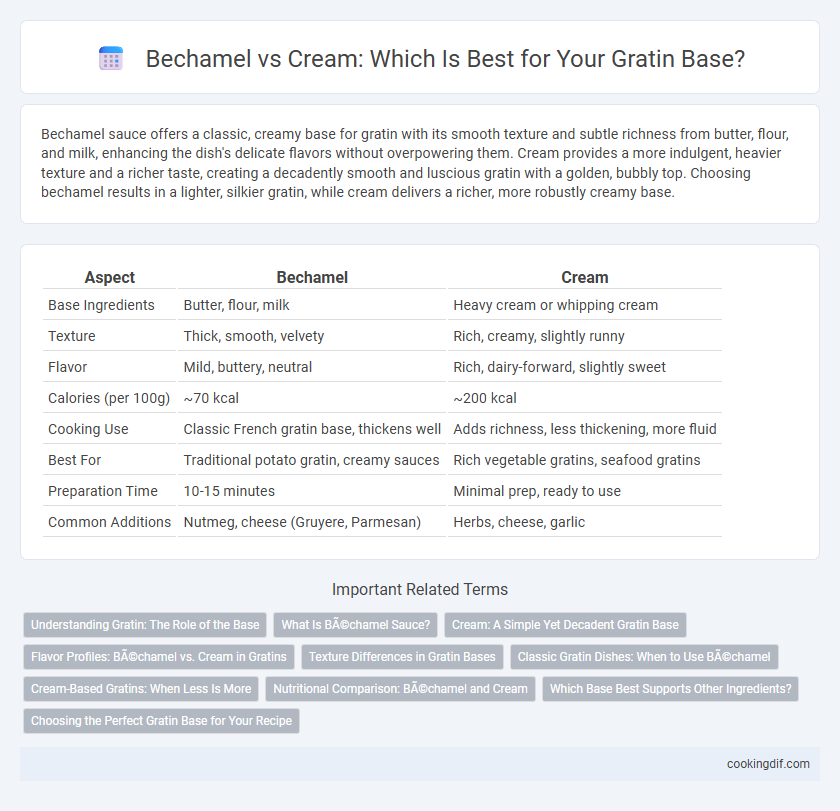Bechamel sauce offers a classic, creamy base for gratin with its smooth texture and subtle richness from butter, flour, and milk, enhancing the dish's delicate flavors without overpowering them. Cream provides a more indulgent, heavier texture and a richer taste, creating a decadently smooth and luscious gratin with a golden, bubbly top. Choosing bechamel results in a lighter, silkier gratin, while cream delivers a richer, more robustly creamy base.
Table of Comparison
| Aspect | Bechamel | Cream |
|---|---|---|
| Base Ingredients | Butter, flour, milk | Heavy cream or whipping cream |
| Texture | Thick, smooth, velvety | Rich, creamy, slightly runny |
| Flavor | Mild, buttery, neutral | Rich, dairy-forward, slightly sweet |
| Calories (per 100g) | ~70 kcal | ~200 kcal |
| Cooking Use | Classic French gratin base, thickens well | Adds richness, less thickening, more fluid |
| Best For | Traditional potato gratin, creamy sauces | Rich vegetable gratins, seafood gratins |
| Preparation Time | 10-15 minutes | Minimal prep, ready to use |
| Common Additions | Nutmeg, cheese (Gruyere, Parmesan) | Herbs, cheese, garlic |
Understanding Gratin: The Role of the Base
Bechamel sauce provides a classic, creamy, and smooth base for gratin, enhancing texture and flavor through its rich combination of butter, flour, and milk. Cream creates a denser, silkier consistency that intensifies richness and promotes golden browning, ideal for gratins requiring a decadent finish. Choosing between bechamel and cream as a gratin base depends on desired creaminess, thickness, and flavor depth, significantly influencing the dish's overall texture and taste.
What Is Béchamel Sauce?
Bechamel sauce, a classic French white sauce made from butter, flour, and milk, serves as a smooth, creamy base in gratin dishes, providing rich texture and subtle flavor that enhances the layers of vegetables or proteins. Unlike heavy cream, bechamel offers a thicker consistency and a mild taste that balances the dish without overpowering it, allowing the gratin ingredients to shine. Its versatility and ability to bind ingredients make bechamel the preferred choice for achieving the signature golden crust and creamy interior typical of traditional gratins.
Cream: A Simple Yet Decadent Gratin Base
Cream as a gratin base offers a rich and velvety texture that enhances the dish's indulgence without overpowering the natural flavors of ingredients. Unlike bechamel, which involves a roux to thicken, cream provides a straightforward, luscious sauce that creates a golden, bubbling crust when baked. Using heavy cream or double cream ensures optimal creaminess and helps achieve the signature silky finish prized in classic gratins.
Flavor Profiles: Béchamel vs. Cream in Gratins
Bechamel sauce offers a rich, velvety texture with a subtle, buttery flavor enhanced by nutmeg, providing a classic, balanced base for gratins. Cream delivers a heavier, more indulgent mouthfeel with a naturally sweet and dairy-forward profile that intensifies the overall richness. Choosing between bechamel or cream impacts the gratin's depth of flavor and texture, with bechamel creating a lighter, silkier finish and cream yielding a luxurious, dense consistency.
Texture Differences in Gratin Bases
Bechamel sauce creates a smooth, velvety texture in gratin bases due to its thickened milk and roux mixture, providing a creamy yet firm consistency that holds toppings well. Cream-based gratins offer a richer and silkier mouthfeel with a looser texture, allowing a more luscious and indulgent bake. The choice between bechamel and cream significantly influences the gratin's final texture, with bechamel lending structure and cream enhancing richness.
Classic Gratin Dishes: When to Use Béchamel
Classic gratin dishes such as Gratin Dauphinois and Potato Gratin traditionally utilize bechamel sauce for their creamy, smooth texture and lightly thickened consistency, which binds the ingredients without overwhelming the flavors. Bechamel, made from a roux of butter and flour combined with milk, provides a subtle, savory base that enhances the natural taste of potatoes and cheese, making it ideal for dishes requiring a balanced richness. Cream bases, while richer and heavier, tend to create a denser gratin, so bechamel is preferred when a delicate, airy finish is desired in traditional gratins.
Cream-Based Gratins: When Less Is More
Cream-based gratins offer a rich and luscious texture while requiring less liquid than bechamel, making the dish more concentrated in flavor. The higher fat content in cream enhances browning and creates a velvety crust, intensifying the gratin's overall sensory appeal. Using cream in moderation prevents the dish from becoming overly heavy, striking the perfect balance between decadence and lightness.
Nutritional Comparison: Béchamel and Cream
Bechamel sauce, made from milk, butter, and flour, offers a lower calorie and fat content compared to heavy cream, making it a healthier base option for gratins. Cream contains higher saturated fat levels, contributing to richer texture but increased calorie density. Choosing bechamel enhances protein and calcium intake while reducing overall fat consumption in gratin dishes.
Which Base Best Supports Other Ingredients?
Bechamel sauce provides a structured, creamy base that enhances the texture and flavor absorption of gratin ingredients such as vegetables and cheese. Cream offers a richer, denser consistency that elevates the dish's decadence but may overpower delicate flavors. The choice between bechamel and cream depends on whether a balanced, smooth foundation or a more indulgent, bold base is desired to support the gratin's primary components.
Choosing the Perfect Gratin Base for Your Recipe
Choosing the perfect gratin base depends on the texture and richness desired; bechamel sauce offers a creamy, smooth consistency with a subtle buttery flavor, enhancing the dish's structure without overpowering other ingredients. Cream provides a richer, more decadent texture with a natural sweetness, ideal for recipes prioritizing indulgence and depth. Balancing these bases allows for customized gratins, where bechamel suits lighter preparations and cream elevates hearty, luxurious dishes.
Bechamel vs Cream for gratin base Infographic

 cookingdif.com
cookingdif.com